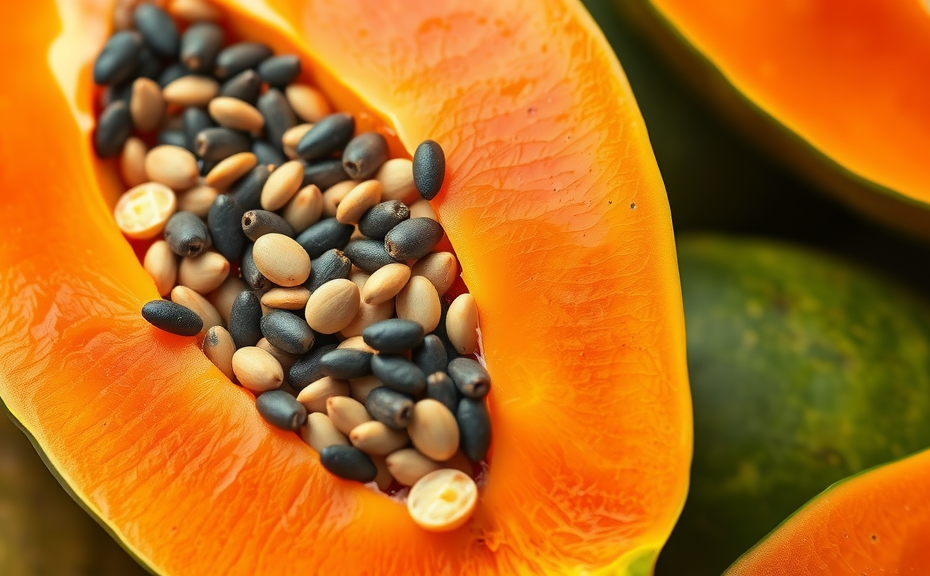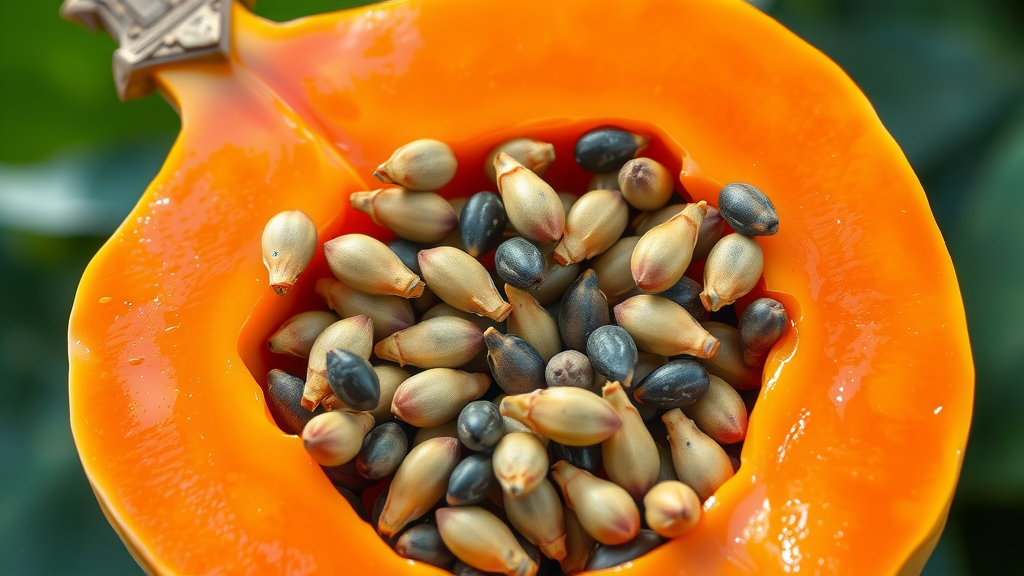Exploring the lesser-known aspects of papaya can uncover fascinating possibilities for culinary experimentation. While the fruit’s sweet flesh is widely enjoyed, the seeds deserve attention due to their intriguing nutritional profile.
These seeds are rich in healthy fats and antioxidants, potentially providing support for digestive health.
They can also be ground into a fine powder, serving as a unique pepper substitute in various dishes.
Similarly, the skin of the papaya, often discarded, contains valuable nutrients. Though its texture is firm, proper preparation can allow it to be integrated into different recipes.
Delving into these unconventional components of the papaya can shed light on their viability as edible options.
The flavor of papaya seeds is notably robust, catering to those with a penchant for unique culinary experiences and an appreciation for their nutritional benefits, as the seeds are not only edible but also packed with essential nutrients that can contribute to overall health.
Can You Eat Papaya Seeds
Small and round, papaya seeds are often overlooked despite their potential advantages. These seeds are not only edible but can also provide various health benefits if incorporated into one’s diet.
Many individuals tend to discard them without recognizing their unique properties.
While it is generally safe to consume them, specific populations, such as pregnant women or those on certain medications, should seek advice from a healthcare provider before doing so.
The seeds contain enzymes known to act as a natural digestive aid, promoting better digestion. When used creatively, their distinct flavor can enhance numerous culinary uses, making them a versatile addition to different dishes.
Nutritional Benefits Of Papaya Skin
The outer layer of the tropical fruit often goes unnoticed and is commonly thrown away, yet it is packed with valuable nutrients. Rich in Vitamin C, the skin supports immune function and aids in collagen production, which is crucial for skin health.
It also offers dietary fiber, promoting digestive wellness and gut health.
A variety of minerals, including potassium, contribute to overall bodily functions, enhancing vitality.
Antioxidants like flavonoids and phenolic compounds present in the skin help combat oxidative stress and reduce inflammation. These benefits may play a role in lowering the risk of chronic diseases.
Incorporating papaya skin into various recipes not only boosts nutritional value but also adds unique flavor profiles.
The skin’s versatility extends beyond nutrition; it has emerged as a popular natural exfoliant in skincare routines focused on food safety practices. This dual application highlights the multifaceted potential of what minerals and tropical fruit can contribute to food safety and innovative recipes for raw consumption.
Papaya Skin
- Papaya skin is rich in Vitamin C, which supports immune function and collagen production.
- The skin contains dietary fiber that promotes digestive wellness and gut health.
- Minerals like potassium found in papaya skin enhance overall bodily functions and vitality.
- Antioxidants in the skin, such as flavonoids and phenolic compounds, help combat oxidative stress and reduce inflammation.
How To Prepare Papaya Seeds
Enhancing the enjoyment and health benefits of consuming papaya seeds involves a straightforward process. Start with ripe papaya fruit, slicing it in half to reveal the seeds.
Carefully use a spoon to scoop out the seeds, ensuring minimal damage.
Following this, the seeds require rinsing under cold water to remove the bitter gelatinous coating.
This cleaning step is important for improving the overall taste experience. Next, the drying phase is crucial for reducing moisture content.
Spread the cleaned seeds on a towel and allow them to dry for 24 to 48 hours. For those interested in transforming the texture, grinding the dried seeds in a spice grinder provides a powdery form, which serves as an excellent smoothie ingredient or addition to fruit salad. Papaya seeds offer notable nutritional advantages, being a rich source of enzymes and dietary fiber, which contribute positively to digestive health and make them an excellent addition to smoothies and fruit salads, elevating their superfood status.
Is Papaya Skin Safe To Eat
The outer layer of papaya is frequently disregarded despite its potential nutritional value. The peel is rich in vitamins A and C, along with antioxidants, all of which can support a healthy immune system.
Although many people opt to discard the skin, it may offer considerable benefits; the tough texture poses a challenge, and there may be concerns about pesticide residue.
Compared to other fruits like cucumbers and apples, whose skins are commonly consumed, papaya skin invites a more cautious approach.
In certain tropical cuisine traditions, this layer is utilized not only as food but also as a natural remedy, demonstrating its multifunctional role beyond mere waste.
Eating papaya skin can be safe when it is thoroughly washed and sourced from reliable providers. Its inclusion in meals may boost nutrient intake and contribute to overall well-being. Creative culinary uses of the peel showcase its versatility and highlight its benefits in tropical cuisine as a natural remedy that supports the immune system.
| Nutritional Benefits | Concerns |
|---|---|
| Rich in vitamins A and C | Pesticide residue |
| Contains antioxidants | Tough texture may be unappealing |
| Supports a healthy immune system | Requires thorough washing |
| Used in tropical cuisine and remedies | Less commonly consumed than other fruit skins |
Culinary Uses Of Papaya Seeds
Often overlooked, papaya seeds can enhance a variety of dishes with their unique characteristics. Their taste profile features a peppery note, making them a versatile flavor enhancer for salads and dressings.
Ground seeds serve as an intriguing substitute for traditional spices like cumin or coriander, imparting a distinct twist to the dish.
Whole seeds add a satisfying crunch to stir-fries and soups, complementing the overall texture.
Soaking them in vinegar or oil creates flavorful infusions, while pickling the seeds transforms them into a tangy condiment. The nutrients found in papaya seeds also offer potential health benefits when incorporated into smoothies or health drinks.
Transitioning from the culinary aspects, it’s important to explore if papaya skin is safe to eat, as it can also play a significant role in various recipes.
Health Benefits Of Eating Papaya Skin
The outer layer of papaya often goes unappreciated, yet it presents a variety of health benefits. Nutritionally dense, the peel is packed with fiber, promoting digestion and supporting a healthy gut.
It offers a range of antioxidants, including flavonoids and carotenoids, which can mitigate oxidative stress in the body.
Rich Nutrient Profile: Notably, the skin contributes significantly to a plant-based diet, offering a high fiber content essential for digestive health.
The antioxidants present can aid in detoxification, providing extra support against free radicals.
Support for Immune Function: Vitamins found in papaya skin are known for their role in bolstering immune defenses. Interestingly, the presence of enzymes such as papain enhances nutrient absorption, making it a valuable component for those following an organic, plant-based diet, including vegan and detoxification practices that focus on whole fruit.
| Benefit | Details |
|---|---|
| Fiber Content | Promotes digestion and supports a healthy gut. |
| Antioxidants | Includes flavonoids and carotenoids that mitigate oxidative stress. |
| Vitamins | Bolsters immune function and supports overall health. |
| Enzymes | Presence of papain enhances nutrient absorption. |
Recipe Ideas With Papaya Seeds
The culinary potential of papaya seeds often remains unrecognized, despite their ability to enhance dishes with a unique flavor profile and crunch. Their peppery taste offers an alternative seasoning option, which can be particularly beneficial for wellness-focused recipes.
A zesty salad dressing can be crafted by blending the seeds with vinegar and herbs, providing a refreshing twist that can elevate any dish.
Creating a spice blend with these seeds allows for a flavorful enhancement of meats and vegetables while actively reducing food waste.
Incorporating them into smoothies not only contributes to overall health but also adds a nutritional boost, thanks to their rich nutrient profile.
Pickling the seeds introduces a distinctive taste, as their versatility allows for creative combinations with various fruits and vegetables. These flavor profiles can transform dishes, making them a worthy addition to any kitchen. Exploring alternative uses of papaya seeds ensures their potential in wellness and natural health, while also contributing to food waste reduction and composting efforts.
Understanding Papayas Digestive Aid Properties
The tropical fruit is not only a favorite for its sweet taste but also for its remarkable role in aiding digestion. Papain, an enzyme inherent in this fruit, is effective in breaking down proteins, which enhances the overall digestive process.
Many people may not realize that this enzyme can significantly ease symptoms of bloating and discomfort following heavy meals.
The engaging nutrient density of this fruit supports a healthy digestive tract, contributing to overall gastrointestinal well-being.
Interestingly, both the seeds and skin of papayas are often neglected in culinary exploration.
These overlooked parts contain unique compounds that may offer various health benefits, including notable antioxidant properties. Incorporating the seeds and skin into your diet can provide an innovative cooking approach, allowing for a broader usage of this versatile fruit and maximizing its digestive benefits.
| Benefit | Details |
|---|---|
| Digestive Aid | Contains papain, an enzyme that helps break down proteins and enhances digestion. |
| Bloating Relief | Can significantly ease symptoms of bloating and discomfort after heavy meals. |
| Nutrient Density | Supports a healthy digestive tract and overall gastrointestinal well-being. |
| Health Benefits of Seeds and Skin | Contain unique compounds with antioxidant properties that are often overlooked. |

